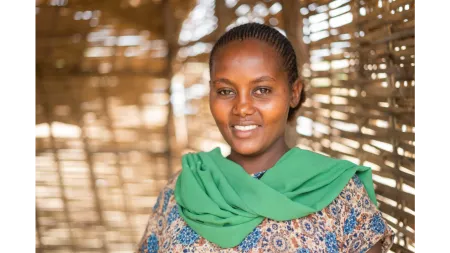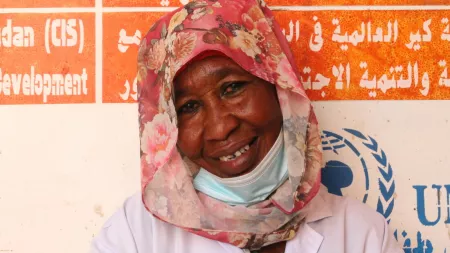How do you get to work every day? Public transportation? A car? A bicycle? Sakina Abdalla is a midwife in Sudan, and when she has to go help a woman facing a crisis during childbirth, she has to be ready for a tough road.
So imagine what having a better ambulance or better transportation for health workers could do for you, especially if you were sure that the health center could repair the vehicle when something broke. If you’re trying to serve women in incredibly challenging situations, what if you could get to them faster, safer, and more comfortably? For CARE in Sudan, that’s just one of the many improvements they helped people make so they could still get health services and clean water during COVID-19.
The Integrated Humanitarian Assistance Project worked with $5 million in funding from USAID’s Bureau of Humanitarian Affairs to help 309,416 people directly reduce the impacts they were facing from COVID-19 in South and East Darfur. The project ran from 2020 to 2022.
“We started our trip on a donkey, [and after] four hours walking I used my experience and I succeeded to rectify the situation and the lady received her 1st newborn.”Sakina, Sudanese midwife
What changed?
- People have 5 more liters of water every day. When the project started, on average, people got 11 liters of water per day. By the end, people were getting an average of 15 liters per day (meeting minimum humanitarian standards). 87% of people could actually get at least 18 liters of water each day.
- People get water faster. The number of people who have to wait more than an hour for water was cut in half. Now, 63% of people wait for less than 30 minutes a day to get water.
- People don’t have to walk so far. Now, 48% of people walk less than 15 minutes to get water, up from 32%. That doesn’t just save time, it also makes people—especially women—safer, because they don’t have to run the risk of walking very far to get water.
- Children are no longer malnourished. The project cured 17,477 children of malnutrition, after screening 117,553 for their nutrition status.
- Children got vaccines. 18,803 children got their full childhood course of vaccines, including measles vaccines.
How did it happen?
- Build local. The project team built local water systems, trained local mechanics, and had local groups consult on what kinds of water systems would work and where they could get replacement parts. Local people consulted on the tariff system to make sure that they could charge enough to repair water systems without charging so much that people could not afford water.
- Buy local. They also bought health equipment—like tuk tuks (motorized carts) for ambulances—in local markets so people always have the tools, access, and parts to repair and replace what they need.
- Run health centers. The project ran 45 health or nutrition centers that provided medical consultations for 167,000 people, nutrition counselling for 118,000 people, and reproductive health services for 21,797 people.
- Train service providers. The project team trained not just health workers, but also local midwives, health committees, and mothers to ensure that the community had support systems to promote health widely, and get people access to services.
- Build and repair infrastructure. The project built 19 motorized water systems, 21 new hand pumps, and repaired 25 existing pumps. They also built 1,127 latrines.
- Give people cash. The project gave cash transfers to 11,000 people. They got $36 over three months to help meet basic needs.
Want to learn more?
Check out the evaluation here.

CARE International has been working in Sudan since 1979. Today, we work primarily in East Darfur, South Darfur, South Kordofan, Kassala, and Khartoum, and focus on providing relief services to internally displaced people, assisting conflict-affected populations to restore livelihoods, and promoting peace and stability. Current activities include improving water and sanitation, hygiene education, primary health care, nutrition, and livelihood support.
Read more